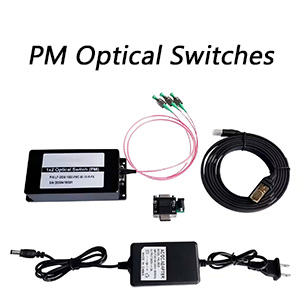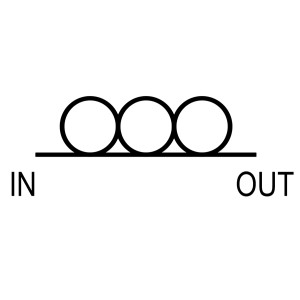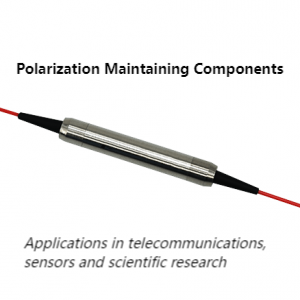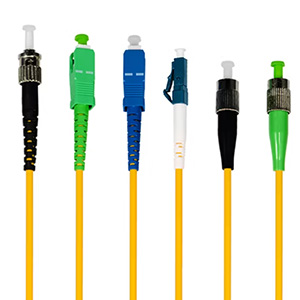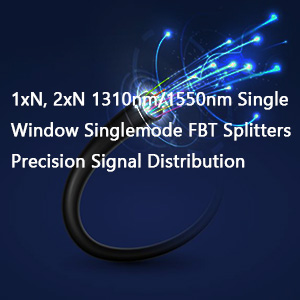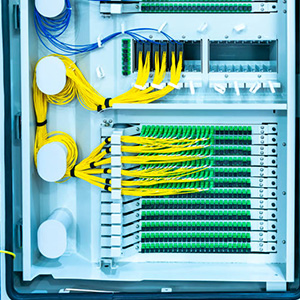CWDM and DWDM are two important technologies in the field of fiber optic communications. They greatly increase the transmission capacity of the network by carrying multiple optical signals on a single optical fiber. However, there are significant differences between the two technologies in terms of application scenarios, number of wavelengths, transmission distance and cost. Understanding the key differences between CWDM and DWDM will help you make smarter choices when designing and optimizing fiber optic networks, ensuring the best balance between network performance and cost-effectiveness.
Understanding WDM, CWDM, and DWDM
To grasp the distinctions between CWDM and DWDM, it’s essential to first comprehend the fundamentals of WDM, CWDM, and DWDM.
WDM: The Backbone of Optical Data Transport
WDM is a transformative technology for transferring substantial volumes of data across locations. It amplifies bandwidth by facilitating the simultaneous transmission of multiple data streams over a single optical fiber network, thereby optimizing fiber usage and enhancing network investments.

CWDM and DWDM: Technological Evolutions
CWDM and DWDM are two technologies that evolved from WDM, each with unique wavelength configurations and applications. CWDM, with its adaptability, can be readily deployed across various fiber networks and is commonly found in point-to-point topologies within enterprise and telecom access networks. In contrast, DWDM, traditionally an option for metropolitan networks, now extends its reach to interconnecting data centers and financial services networks, often utilizing a ring topology.
The Distinctions Between CWDM and DWDM
CWDM and DWDM are both potent solutions for the escalating demand for bandwidth in information transmission. However, they exhibit several key differences:
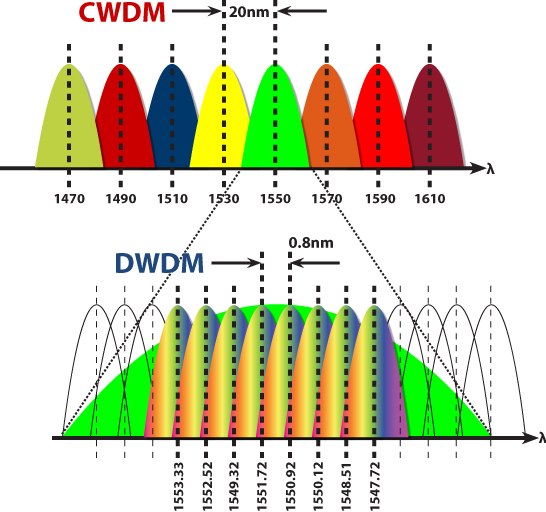
Channel Spacing: The Crucial Divide
Channel spacing, the nominal difference in frequency or wavelength between adjacent optical channels, is markedly wider in CWDM than in DWDM. CWDM accommodates up to 18 wavelengths with a 20nm channel spacing across the 1271nm to 1611nm spectrum. DWDM, with its narrower 0.8/0.4nm (100 GHz/50 GHz grid) spacing, can support 40 to 160 wavelengths, primarily within the C band (1525nm to 1565nm) and L band (1570nm to 1610nm).
Transmission Distance: Reaching Further with DWDM
While CWDM has a maximum reach of approximately 160 km, DWDM surpasses this limit, thanks to its highly integrated wavelengths with fiber during transmission. An amplified DWDM system can extend its reach even further.
Modulation Laser: The Heart of the System
CWDM employs uncooled lasers, whereas DWDM relies on cooled lasers, which use temperature tuning for superior performance, safety, and longevity. However, this comes at the cost of higher power consumption compared to the electronic tuning of uncooled lasers in CWDM.
Bandwidth: The Capacity for Data
CWDM channels carry less bandwidth than DWDM. While CWDM pluggable transceivers can reach 100 Gbps and integrated components can surpass 1 Tbps, CWDM’s current maximum is capped at 400 Gbps.
Application: The Spheres of Influence
CWDM is extensively used in cable TV networks and with transceivers like GBIC and SFP CWDM optics, providing standardized wavelengths for efficient data transmission. Passive CWDM, ideal for FTTP, operates without power and utilizes passive optical components. It supports cost-effective transmission for data, video, and voice signals. DWDM, on the other hand, is prevalent in telecom and cable networks for long-distance, high-bandwidth, and secure applications, playing a pivotal role in core and metro networks and in high-throughput data centers for service integration and geo-distributed architectures.
Cost: The Economic Factor
The wide wavelength range of DWDM and the associated temperature tuning challenges increase the cost of DWDM systems, which are typically four to five times pricier than CWDM systems. However, the widespread adoption of DWDM has reduced the price gap, with DWDM transceivers costing about 20-25% less than their CWDM counterparts.
Advantages and Disadvantages: Weighing the Options
The primary difference between DWDM and CWDM lies in channel spacing, with CWDM offering nearly 100 times wider spacing. This simplicity brings both advantages and disadvantages concerning cost and performance.
Choosing Between CWDM and DWDM
The escalating demand for bandwidth has bolstered DWDM’s popularity due to technological advancements and cost reductions. However, CWDM maintains a cost advantage for lower data rates and short distances, making it a viable option for certain applications. Both CWDM and DWDM will continue to play complementary roles in the OTN network.
No matter your preference for DWDM or CWDM, Fiber-Life offers a comprehensive suite of products tailored to your needs. With a wide array of CWDM and DWDM equipment, including Mux/Demux and OADM, Fiber-Life also provides an extensive selection of modules and customizable solutions to ensure you find the perfect fit for your project.

